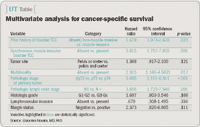Article
Factors predicting bladder TCC survival identified
A multi-institutional retrospective analysis has identified five variables that independently predict cancer-specific survival in patients with nonmetastatic transitional cell carcinoma of the upper urinary tract.
Anaheim, CA-A multi-institutional retrospective analysis has identified five variables that independently predict cancer-specific survival in patients with nonmetastatic transitional cell carcinoma of the upper urinary tract.
The study was based on a review of data from 269 patients who had undergone nephroureterectomy between 1980 and 2004 at one of three urologic centers in Europe. Median follow-up for the entire cohort was 34 months. Fifty-seven cancer-related deaths and 34 deaths from other causes occurred during follow-up. Median follow-up for patients who were still alive and disease-free was 52 months.
The 5-year, cancer-specific survival rate estimated with Kaplan-Meier methods was 76%.

"We believe these observations may be useful for counseling patients after surgery and to identify those with unfavorable cancer-related outcomes who might be appropriate subjects for future neoadjuvant or, rather, adjuvant, randomized, controlled trials," Dr. Novara said.
The study was coordinated by Vincenzo Ficarra, MD, of the University of Padua. The two other participating centers were the University of Verona, Italy, and Rennes University, France.
Of 269 patients in the study population, 75% were men. Mean age of the en-rollees was 68 years. A history of upper tract TCC was absent in 87% of patients, while 48% of patients had prior bladder TCC. Of the 129 patients with prior bladder TCC, the disease was muscle invasive in 19 patients (14.7%). At the time of nephroureterectomy, 19 patients (7%) were found to have synchronous muscle-invasive bladder TCC, Dr. Novara reported.

Results of pathologic staging showed 45% of patients had non-muscle-invasive upper tract disease, 20% had pT2 cancer, 28% had pT3 cancer, and 6% had stage pT4 disease.
Dr. Novara noted that histologic grading was performed using the 1973 World Health Organization system, although a centralized review of slides was not possible. Most patients had G2 (41%) or G3 (50%) disease. Lymphovascular invasion was present in 16.4% of patients.
The log-rank test was used for univariate analysis of predictive factors. Those results showed that older age (>65 years) and prior history of upper tract TCC had no significant predictive value. A trend was seen only in patients with de novo upper tract TCC to have a higher 5-year, cancer-specific survival compared with patients who had non-muscle-invasive bladder TCC.
"These results may be a consequence of our relatively small patient population. However, we did find that patients with muscle-invasive bladder cancer had a significantly lower 5-year, cancer-specific survival compared to patients with non-muscle-invasive disease (47% vs. 73%)," Dr. Novara said.















